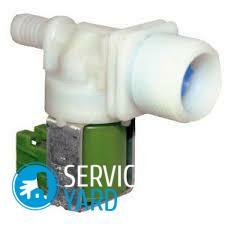
- Operating principle
- Types of valves
- Checking the operation
- Repairing the valve
- Replacing the valve
The solenoid valve is designed to supply water to the washing machine. At the entrance to it, a water supply hose is connected, and at the outlet it is connected to a connection with which water is put in the hopper of the dispenser. How the valve works for the washing machine for water, what are the options for its device, how to check the working life of the device and repair it - all this you will learn from this article.
to Contents ↑How it works
The inlet valve for the washing machine can be in two functional states: closed and open. The part is equipped with a coil, which receives electric current and produces an electromagnetic field. As a result, it opens, and water enters the washing machine.
When filling the tank to the required level, a command is issued from the control module to stop the power supply to the valve. As a result, it closes and no more water is supplied.
Important! The valve for the washing machine for water differs throughput of 10-12 liters per minute.
to Contents ↑Valve Types
The solenoid valve for the washing machine is characterized by the number of sections. Water is supplied through each of them.
Structural differences%
- The most common is the installation of an intake damper with one circuit. Water is simultaneously fed into the drum and other systems.
- For more functional units use two and three-sectional models.
Important! In general, the work of all models of intake systems is the same. The electromagnetic coil is energized, the plug is opened and the water is supplied. After the power is cut off, the plug closes.
A little about the mechanic
Mechanical water supply systems are now used rarely. They were used for old washing machines, in which there was no electronic control unit. In such valves there is only one circuit, for the opening of which operates a built-in mechanical drive. In order to close it, the device has a damper.
Important! The mechanical valve for a washing machine for water is very simple: there are no control elements, there is only a spring. Such systems are very rare.
to the contents ↑Checking the operation of the
To check the valve for the washing machine for water, it is dismantled, connected to the filling hose and in turn, the voltage is applied to the coils. If it is working, it opens, and when the power disappears, it closes tightly.
In addition to the general functionality, individual components of the device are subject to maintenance, especially if any malfunctions or defects in the washing machine are noticed:
- The valve grid is being checked. When the grid is clogged, water stops flowing. The grid is extracted, cleaned and installed again.
Important! Such a fault is indicated by the absence of a set of fluids or by the very slow dialing speed.
- In the event that there was no opening of the intake system, the coil must have burnt out. For its verification, the resistance is measured, the indicators of which should be at a level of 2-4 kOhm.
- If the shutter is normally opened, but after the power is turned off, the leakage of water continues - this indicates the loss of the membrane flexibility or the weakening of the stem spring.
Important! In this case, replacement of the part is required, since after its re-installation the water will still leak.
- Check is also required with plastic inserts in the unions. Most often they are used on a fitting, through which water enters a compartment with a rinse aid. If the insert drops out, the water begins to overfill the compartment. Damaged filler for the washing machine must be changed.
Repair of the
valve This part is usually not repaired, but immediately changed. It is possible to replace the burnt coil with a similar one. But experts recommend not to do so, as efforts can remain unjustified.
to the table of contents ↑Replacing the
valve If you need to replace the water supply valve for the washing machine, it is enough to follow the instructions below:
- Find the location of the intake valve. Most often - this is the top of the stylalki, but if the load is vertical, it is placed from the bottom. The washer is de-energized. The water supply is blocked, the water inlet hose is disconnected.
- The top cover is removed. To do this, the self-tapping screws located at the rear are loosened, the cover is moved and removed. If the machine is vertical loading, the side wall is removed.
- Disconnect all wires and hoses from the broken element. For fastening the hoses use clamps that can be used repeatedly.
Important! Sometimes disposable clamps are installed, then it is necessary to think about new ones for replacement in advance.
- To detach the valve from the housing, unscrew the fixing bolts or bend the latches.
- The old part turns and pulls out.
- The new spare part is installed in the reverse order.
- Functionality is checked, washing is started.
Important! You must remember how the hoses and wires were located. It's even better to photograph them when disassembling them.
Without a washing machine it is difficult to imagine a modern apartment. Its availability greatly facilitates life and saves time. The main thing is to monitor its condition and it will please more than one year.
